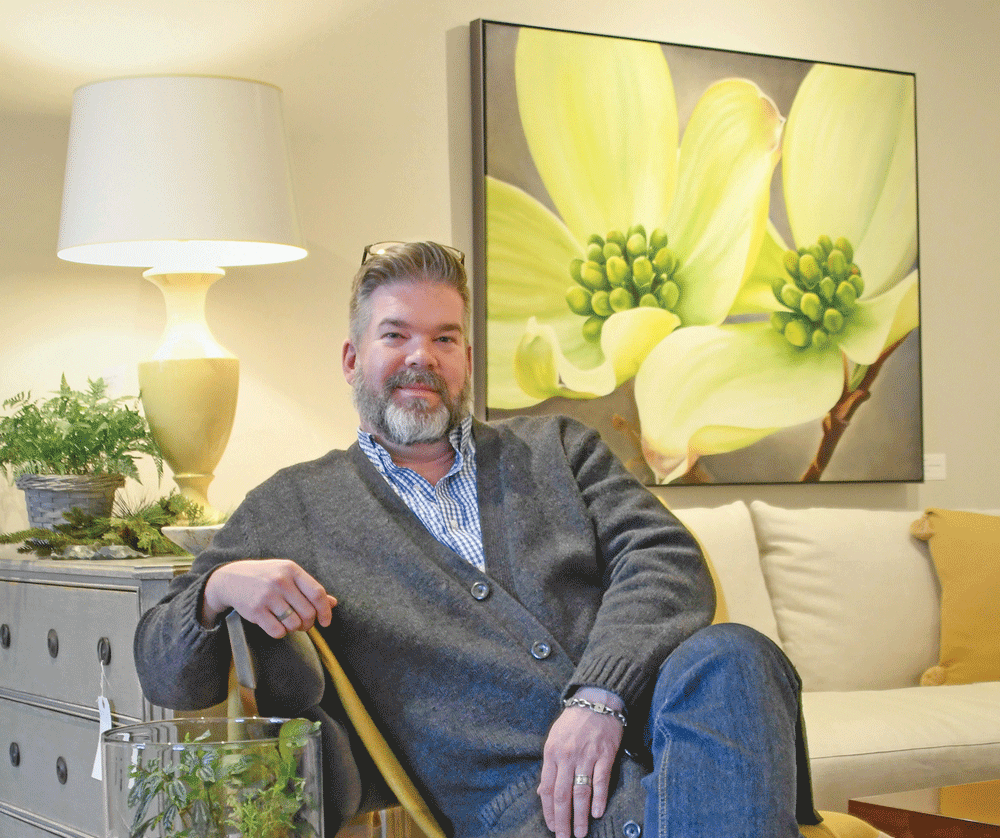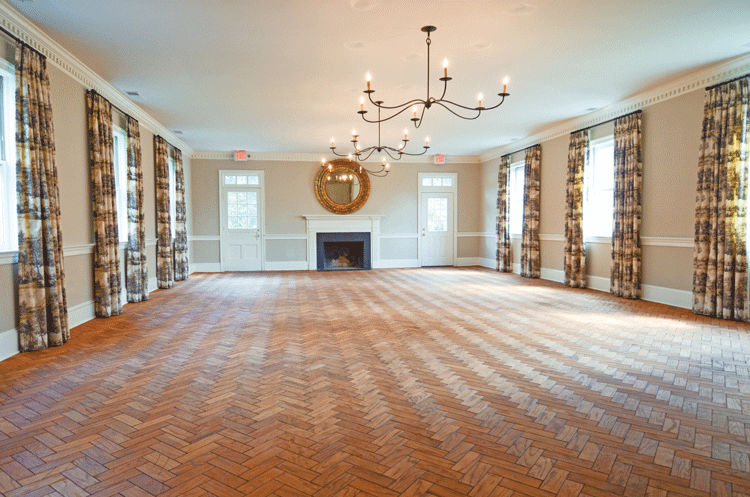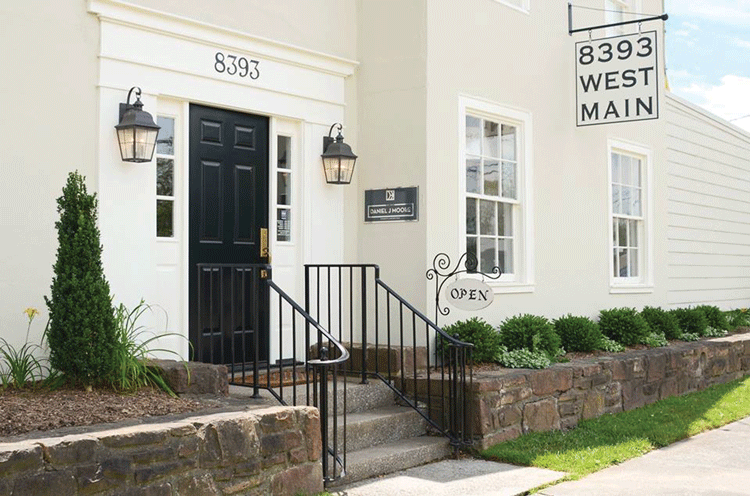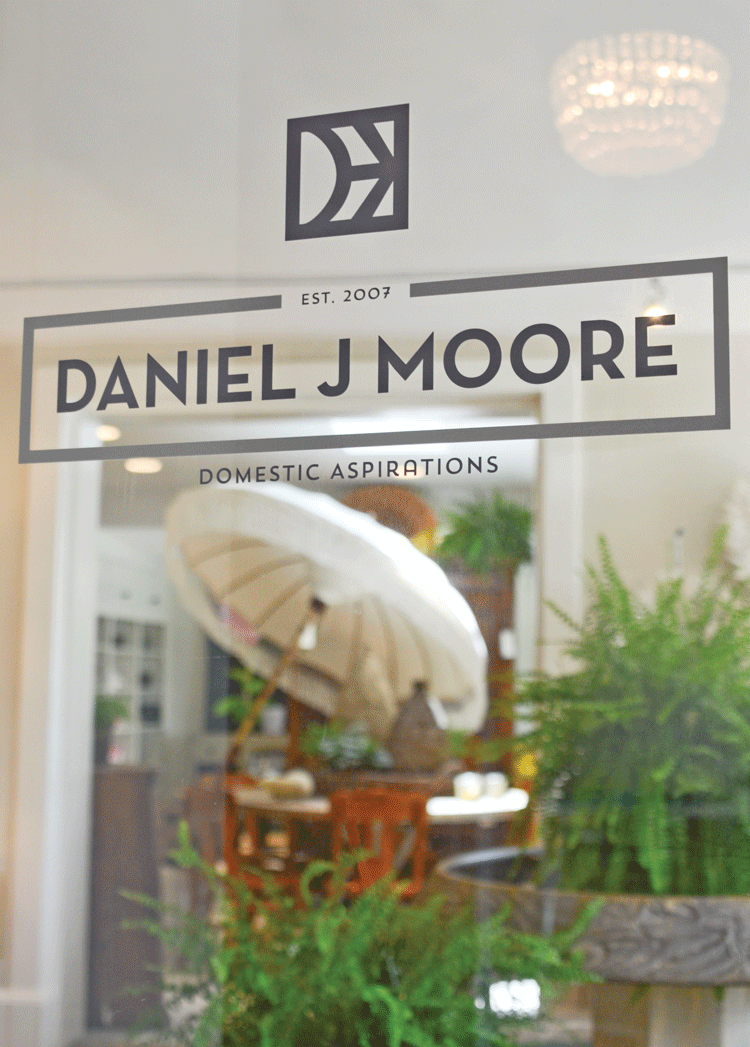The Many Artistic Expressions of Daniel J. Moore

Whether in theater, design or hospitality, he’s never lacked inspiration.
By Beth Rasin
Photos by Tara Jelenic Photography
[dropcap size=small]I[/dropcap][dropcap size=big]I[/dropcap]t all started inside a living room fort in California’s Central Valley. Drawing back the curtains, you’d enter a miniature “Ben Hur” movie set made from bedsheets, construction paper and cardboard. Even as a child, Dan Moore, now of Daniel J. Moore Design and Domestic Aspirations in Marshall, Virginia, was exploring the many outlets for his natural creativity.By high school, he’d discovered technical theater—building sets, taking acting classes, dance, choir—and he ended up on stage. He was accepted to the prestigious Pacific Conservatory of the Performing Arts, and he went on to act and perform professionally for 10 years.
He performed in everything from “Sweeney Todd” to “The King And I,” “Crazy For You,” “Mame,” “Cabaret” and many more. But it’s now been 15 years since he set foot on stage.
“The gypsy performer lifestyle, acting in regional theater from Montana to Pennsylvania to California, is not very lucrative,” says Moore, who supplemented that career by working in scene shops or costume shops. “It’s very fulfilling as self-expression, but financial security is not guaranteed.”

Moore would soon refocus his talents into a new artistic endeavor—but first he had a stopover in the world of finance. He’d moved to New York for personal reasons, and after working as a temp in a finance office, he was offered a permanent position, ending up as the assistant to the chief compliance officer.
“I had a window, a desk that faced Central Park,” he says. “I would take photos from my desk, and people couldn’t believe it. I was on the 36th floor of a high rise in midtown Manhattan with this view. It afforded me financial security I didn’t have as an actor, but I missed the creative outlet. It was hard for me to sit at a desk all day. Since high school I’d have sometimes seven dance classes a week, along with acting, so I was on my feet moving all day, and now here I was sitting at a desk.”
In addition to his fabulous office, Moore and his partner Shawn Cox inhabited enviable apartments, with Moore using the space as an outlet for his stifled creativity.
“So friends starting asking me to go shopping with them for paint or materials,” he says. “It took me back to my grandmother’s living room or painting sets. I was like, ‘Why don’t I really do this?’ I sat up until 3 a.m. one night making a résumé, and I started interviewing with interior designers.”
Within two weeks he had two offers, including with the renowned Lars Bolander. “He worked with Martha Stewart, had lots of celebrity clients,” recalls Moore. “I had no idea at the time; I just knew I liked the aesthetic of the shop. To have my first professional experience be with someone of his [stature] is unbelievable.”
Moore’s natural design tendencies complimented Bolander’s to a large degree. “This place looks much more like Lars,” he says as he sits in Domestic Aspirations, calling it “new traditional style.” “It’s not about matching borders. It takes a keen, discerning eye and experience. We’re professional shoppers. It took me years to learn that people hate shopping, and I love it. Part of what keeps me going is the notion in the back of my head that I’m being paid to shop.
“There are some things here people would walk in and never have seen before,” he adds. “Not everyone’s seen a juju hat. They’ll say, ‘That’s so cool.’ ”

But Moore eventually moved on from Bolander to Clodagh Design, a 1997 Hall of Fame inductee whose firm recruited him. There he worked in a style he deems “contemporary organic modern, six-inch slabs of concrete, spare, neutral, incredible light and shadows and shape but simplicity, kind of anti-design,” he says. “She won awards and the respect of so many industry leaders. If you respond to modern design, her aesthetic is unbelievable; she is a visionary.”
Coming To The Commonwealth
After gaining experience alongside some of the best designers in the world, Moore was slowly making his exodus from Manhattan.
“We came down here [to Virginia] and said we are finding a place in the country, because we don’t vacation regularly; we’re kind of workaholics,” says Moore.
When Moore and Cox saw the old rectory, circa 1850s, in Hume, they knew it was right for their home. “Now we spend all our time sitting on the couch with two dogs in a house where no one can find us,” says Moore.
He celebrated the 10th anniversary of his design business in the spring of 2017 and his sixth year in Virginia, though he continues to design all over the country, including flying to a Midwestern city to decorate a home for Christmas each year.
“I work in context—the geographic location, the inherent arch of the home, the client’s personal taste and my professional experience,” he says. “The best compliment I’ve been given is, ‘I’m so impressed with how little my house looks like yours.’ You can see my hand in it, but the context is different with different locations.”
Although he hails from a middle class family, Moore says they always appreciated the value of finer things. “I was very close to my mother’s mother, and one of the things she instilled in me more than anything was to acquire the highest quality you can and take care of it, as opposed to being just concerned with the bottom line,” he says. “Her interest was in value. That plays a role in my design work now. It doesn’t matter if it’s 50 cents; if it’s cheap plastic, it’s not worth it. I want my clients’ dollars to go to merchandise, not markup or my time. I want them to get the most they can, and that really comes from her—finding something really well made, even if it’s second hand, and maintaining it. I really appreciated that. It’s how we design a house.”
Marshall Main Street
When Moore purchased a two-story building on Marshall’s Main Street, he let the historic structure speak to its new purposes. He and co-owner Dianna Campagna transformed the upstairs to an inn, which they call The Rooms Up There. It hosts visitors to local vineyards and people coming to experience Marshall’s latest culinary options.
The attached greenhouse and back room have been converted into an event venue called The Drawing Room. Both enterprises showcase Moore’s elegant style and create a warm, inviting space where you want to stay and relax. The rooms, for example, offer a common sitting area stocked with comfortable couches, drinks and snacks.
The original structure of the building, erected in 1805, remains, although it’s not fully intact because a second story was added. The attached two-story log structure used for the storefront of Domestic Aspirations was built in the 1920s; most additions were made with commercial purposes in mind, but it was used as a residence at some point before the 1970s.
Moore sees Domestic Aspirations, which showcases furniture and design accessories, as having the same relaxing, enticing qualities as the inn and event venue.
The shop is secondary to the design business,” he says as he sits on a couch in his store in a long wool sweater, red-checkered shirt and jeans. “It’s like a reward, a nice respite when you’re antiquing or walking around town to see something new and fresh in a really comfortable environment. It lends a sense of importance to the design business, additional credibility and grounding. It also allows us to offer better discounts to people who have hired us, since we can buy at a better rate for the shop.”
Moore’s played his role in the Marshall business community’s renaissance over the last couple of years. He joined the Chamber of Commerce, Marshall Business & Residents Association and is president of Blue Ridge Flower Club, which is more than 80 years old.

“It had been 30 women for all of its 80 years,” says Moore, “and you’re invited by invitation and vote. I was the first ‘active’ male member, and I’m so proud and inspired by them. They’re in Marshall, Hume, Markham, Orlean, this very rural area, ostensibly conservative, but they felt like they should have a male member and one who is president. They are my mafia. They’re a great source of strength for me out here. When they get wind of anything going awry, they are like, ‘Mmm hmm.’ They are not to be fussed with.”
He also appreciates the symbiotic partnerships of the Marshall businesses. “All the businesses on Main Street are benefitting each other,” he says. “We use Twisted Stems, so people can add flowers when they book their room online. We give guests breakfast at Red Truck. When Field & Main has their wine dinners, they have all the rooms blocked. I love being part of the community.”
Moore and Campagna have donated rooms to fundraisers for the Grace Episcopal Church in The Plains, Mountainside Montessori in Marshall and Arts By George, a scholarship fundraiser for George Mason College of Visual & Performing Arts.
Even Moore’s pastimes have an artistic bent: going to the theater, whether community theater, the Lincoln Center or The National Theatre. But his true love is also his profession: antiquing, shopping and browsing.
“It’s my business but also my interest and hobby to start with,” he says. “It’s something that comes naturally. In a way I’m being paid to do my hobby.” ML

Daniel J. Moore is bringing Deb Bowman to The Drawing Room in Marshall, Virginia, on January 27 for a one-night jazz cabaret concert. “She’s like my sister, a successful vocalist in Atlanta, a singer, dancer and actress,” he says. Tickets are $65, and the evening will feature a three-piece ensemble from George Mason University in the two-hour show, as well as heavy hors d’oeuvres, cocktails and dessert for a maximum of 75 attendees. Find out more at thedrawingroomat8393.com[/button] [/column][column size=one_half position=last ]



